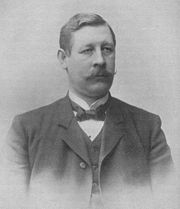
Alfred Petersson
Encyclopedia

Petersson was born into a well-to-do farmer's family in Söderåkra
Söderåkra
Söderåkra is a locality situated in Torsås Municipality, Kalmar County, Sweden with 963 inhabitants in 2005....
parish, Kalmar County
Kalmar County
Kalmar County is a county or län in southern Sweden. It borders the counties of Kronoberg, Jönköping, Blekinge and Östergötland. To the east in the Baltic Sea is the island Gotland....
, and took over the family farm Påboda in 1887. He was active in local and regional politics. In 1894 he both became a member of the Kalmar County Council and was elected member of the Second Chamber of the Swedish parliament.
Appointed minister of agriculture in the short-lived coalition cabinet of Christian Lundeberg
Christian Lundeberg
Christian Lundeberg was a Swedish politician who served as Prime Minister of Sweden from 2 August to 7 November 1905....
, formed in 1905 specifically to handle the issue of the dissolution of the union with Norway, he was the first farmer to become a member of the Swedish cabinet and took an active part in the negotiations with Norway.
He was instrumental in the downfall of the liberal cabinet of Karl Staaff in 1906 over the issue of suffrage
Suffrage
Suffrage, political franchise, or simply the franchise, distinct from mere voting rights, is the civil right to vote gained through the democratic process...
. Staaff's proposition was to extend the right to vote to adult males having paid their state and municipal taxes. The so-called Påboda program was to have proportional elections
Proportional representation
Proportional representation is a concept in voting systems used to elect an assembly or council. PR means that the number of seats won by a party or group of candidates is proportionate to the number of votes received. For example, under a PR voting system if 30% of voters support a particular...
to both parliamentary chambers, rather than the majoritarian system in place and retained in the Staaff proposition. After the first chamber preferred the Påboda program to Staaff's proposition, the cabinet resigned.
Petersson was offered the premiership
Prime Minister of Sweden
The Prime Minister is the head of government in the Kingdom of Sweden. Before the creation of the office of a Prime Minister in 1876, Sweden did not have a head of government separate from its head of state, namely the King, in whom the executive authority was vested...
by the king, but declined and accepted the ministry of agriculture once more in the cabinet of the conservative leader Arvid Lindman
Arvid Lindman
Salomon Arvid Achates Lindman was a Swedish Rear Admiral, Industrialist and conservative politician...
. The new suffrage proposition presented by the Lindman cabinet was based on Petersson's original program, with some changes, was accepted by both chambers in 1907 and finally became law in 1909.
Petersson resigned from the cabinet in 1909 (together with the minister of foreign affairs Erik Birger Trolle and the minister without portfolio Gustaf Roos) because of a disagreement with Lindman over the work of the parliamentary committees and the interpretation of the Riksdagsordningen (or R.O., the law regulating the work of the parliament). Petersson joined the Liberal party and was reelected as a representative in the First Chamber for that party and the Gävleborg County
Gävleborg County
Gävleborg County is a county or län on the Baltic Sea coast of Sweden. It borders to the counties of Uppsala, Västmanland, Dalarna, Jämtland and Västernorrland. The capital is Gävle.- Administration :...
in 1910 but sat as member for Jönköping County
Jönköping County
Jönköping County is a county or län in southern Sweden. It borders the counties of Halland, Västra Götaland, Östergötland, Kalmar and Kronoberg. The capital is Jönköping.- Provinces :...
from 1911 and finally for Stockholm County
Stockholm County
Stockholm County is a county or län on the Baltic sea coast of Sweden. It borders Uppsala County and Södermanland County. It also borders Mälaren and the Baltic Sea. The city of Stockholm is the capital of Sweden. Stockholm County is divided by the historic provinces of Uppland and Södermanland...
from 1919 until his death the following year. He was again minister of agriculture in the second Staaff cabinet 1911-1914 and finally, for the fourth time, in the coalition cabinet of Nils Edén
Nils Edén
Nils Edén was a Swedish historian and liberal politician, Prime Minister of Sweden 1917–1920, and along with Hjalmar Branting acknowledged as co-architect of Sweden's transition from quasi-absolute monarchy to a parliamentary democracy with equal male and female suffrage.Edén was born in...
1917-1920. After the resignation of the Edén cabinet in March 1920, he was appointed Governor of Stockholm County, but died on his farm Påboda in October, before actually taking office.

